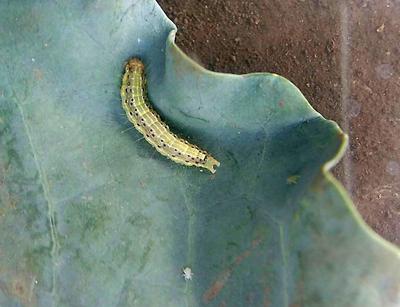Cabbage Leaf Webber
Crocidolomia binotalis
Insect
In a Nutshell
- Holes in the leaves.
- Excreta of caterpillars on leaves and heart of cabbage.
- Greyish-brown moths with black spot and pale brown zigzag lines on the front wing.
Can also be found in
Symptoms
Initial symptoms are characterized by a silken web that wraps around the leaves. Feeding damage can be seen on leaves, leaving them skeletonized. The inner leaves of cabbages are often damaged. They feed on flower buds and also leave boreholes in pods. Excreta of caterpillars will be left over the leaves and hearts of cabbages. The eggs can be found on the lower side of the leaves. The health of the affected plants gets deteriorated due to the leaf damage.
Recommendations

Organic Control
Use Bacillus thuringiensis as soon as the damage is seen (should be applied in the evening). Thoroughly cover the plants by careful spraying as the scope is to kill the caterpillars by making them consume the insecticide. The eggs are not susceptible to Bt, but small larvae are more susceptible than the fully grown ones. Use fresh neem, lemongrass, ginger or other botanical pesticides @ 1 lit / 15 lit of water.

Chemical Control
Always consider an integrated approach with preventive measures together with biological treatments, if available. Avoid using broad spectrum insecticides (such as pyrethroids and organophosphates) as they will kill the natural predators. Spray insecticides, such as Phosalone, Fenvalerate, Cypermethrin or Deltamethrin. Do not repeat the insecticides with a similar mode of action.
What caused it?
Damage is caused by the larvae of Crocidolomia binotalis. The larvae rarely attack seedlings but feed on all stages of the plants. Eggs are laid on the lower side of the outer leaves in clusters of 40 to 100. They appear pale green at first, and later become bright yellow and brown just before hatching. Newly hatched caterpillar larvae are about 2 mm long and they grow up to 20 mm with long hairs when mature. In the later stages, they make thick webs over the leaves and the caterpillars feed beneath them. Moths are usually active during the night, and can infest the crops from early stages up to harvest period. It also infests radish, mustard, turnip and other crucifers. The excreta make the vegetable inconsumable.
Preventive Measures
- Use only pest-free seeds for planting.
- Check seedlings in the nursery for egg masses and young caterpillars.
- If found, remove the leaves or the entire plant and destroy them.
- Use Mustard (Brassica juncea) or Chinese cabbage as a trap crop by planting it as a companion crop between rows of cabbages.
- Plant the first row of mustard about 15 days before transplanting the cabbages, and the second row about 25 days after transplanting.
- Prevent caterpillar entry by using nets and cover plants with insect-proof mesh or fleece.
- Monitor susceptible plants on a daily basis during the growing season and remove any eggs or caterpillars that are found.
- Remove and destroy the webbed leaves with caterpillars within the plant.
- Destroy crop residues immediately after harvest.



